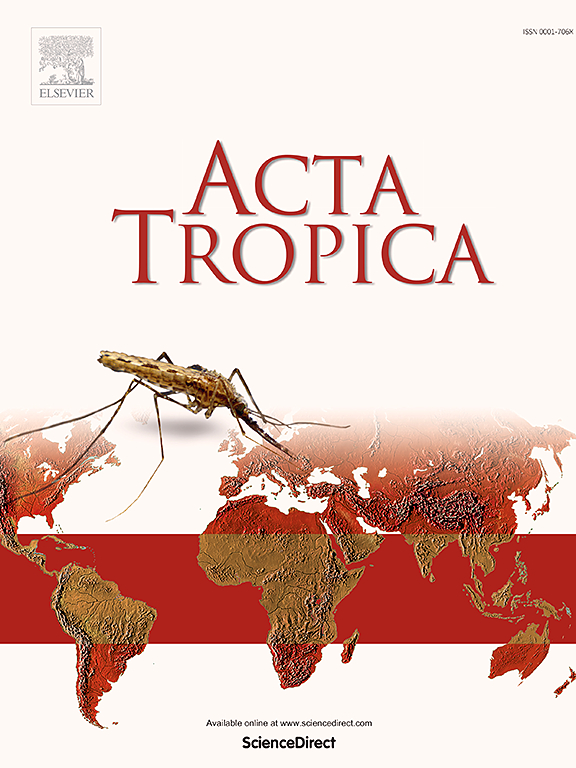Epidemiology, molecular diversity and zoonotic implications of Echinococcus granulosus sensu stricto (G1) in cattle across Nigeria: Evidence of broader transmission dynamics
IF 2.5
3区 医学
Q2 PARASITOLOGY
引用次数: 0
Abstract
Cystic echinococcosis (CE), caused by Echinococcus granulosus sensu lato, is a major zoonotic disease with significant public health and economic impacts. Despite its endemicity in Africa, molecular data on Echinococcus granulosus s.l. genotypes in Nigeria remain limited, with existing knowledge primarily derived from sparse epidemiological studies. This study presents the first nationwide molecular assessment of CE in Nigerian cattle, evaluating prevalence, genetic diversity, and risk factors.
We conducted a cross-sectional study across four abattoirs to investigate the zoonotic risk of cystic echinococcosis (CE) by examining the fertility, organ distribution and molecular characterization of the hydatid cysts in cattle, genotyping by polymerase chain reaction (PCR) and sequencing of the cytochrome c oxidase subunit 1 (cox1) and NADH dehydrogenase subunit 1 (nad1) genes. Results revealed an overall CE prevalence of 2.05 %, with regional variations (highest in Abubakar Saraki [5.79 %] and Akinyele [2.59 %]). Cysts were primarily found in lungs (1.62 %) and liver (0.43 %). Molecular analysis identified E. granulosus sensu stricto (G1 genotype) as the dominant genotype, with 3 cox1 and 6 nad1 haplotypes demonstrating substantial genetic diversity. Regional differentiation suggested localized transmission linked to livestock movement.
This study provides crucial epidemiological and genetic data on E. granulosus sensu stricto in Nigeria, confirming the presence of the globally dominant G1 genotype and highlighting significant genetic diversity. The findings emphasize the need for a region-specific, One Health-based approach integrating veterinary, medical, and environmental interventions to control CE. Future research should focus on expanding surveillance to other intermediate hosts and evaluating control strategies to mitigate disease transmission.
尼日利亚牛中严格感细粒棘球绦虫(G1)的流行病学、分子多样性和人畜共患意义:更广泛传播动态的证据。
囊性棘球蚴病是由细粒棘球绦虫引起的重大人畜共患疾病,对公共卫生和经济造成重大影响。尽管它在非洲流行,但尼日利亚细粒棘球绦虫基因型的分子数据仍然有限,现有的知识主要来自稀疏的流行病学研究。这项研究提出了尼日利亚牛CE的第一个全国分子评估,评估了患病率、遗传多样性和风险因素。通过对牛包虫病的繁殖、器官分布和分子特征、聚合酶链式反应(PCR)基因分型以及细胞色素c氧化酶亚基1 (cox1)和NADH脱氢酶亚基1 (nad1)基因的测序,我们在4个屠宰场进行了横断面研究,以调查囊虫病(CE)的人畜共患风险。结果显示,总体CE患病率为2.05%,存在区域差异(最高的是Abubakar Saraki[5.79%]和Akinyele[2.59%])。囊肿主要见于肺(1.62%)和肝(0.43%)。分子分析表明,G1基因型为优势基因型,3个cox1和6个nad1单倍型具有丰富的遗传多样性。区域差异表明局部传播与牲畜运动有关。该研究提供了尼日利亚严格感细粒绦虫的重要流行病学和遗传学数据,证实了全球优势G1基因型的存在,并突出了显著的遗传多样性。研究结果强调,有必要采取一种针对特定区域的、以“同一健康”为基础的方法,将兽医、医疗和环境干预措施结合起来,以控制CE。未来的研究应侧重于将监测扩大到其他中间宿主,并评估控制策略以减轻疾病传播。
本文章由计算机程序翻译,如有差异,请以英文原文为准。
求助全文
约1分钟内获得全文
求助全文
来源期刊

Acta tropica
医学-寄生虫学
CiteScore
5.40
自引率
11.10%
发文量
383
审稿时长
37 days
期刊介绍:
Acta Tropica, is an international journal on infectious diseases that covers public health sciences and biomedical research with particular emphasis on topics relevant to human and animal health in the tropics and the subtropics.
 求助内容:
求助内容: 应助结果提醒方式:
应助结果提醒方式:


